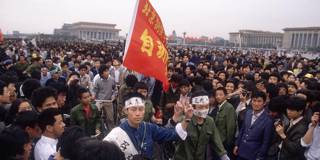China’s tragic modern political history has led some, inside and outside China, to believe that the Chinese are not ready for liberal democracy, or are even unsuited to it. But the more liberal strands of the May Fourth Movement in 1919 – and of the 1989 Tiananmen Square protests that May 4 inspired – should never be forgotten.
NEW YORK – This month marks the centenary of one of the most important cultural and political episodes in modern Chinese history: the May Fourth Movement. On May 4, 1919, Chinese students and intellectuals launched a massive protest in Beijing, demanding the end of “feudalism” and more political freedom. A century later, it is officially celebrated by a Communist dictatorship that allows no protest, let alone one led by students. May 4 inspired another revolt, in Tiananmen Square from April to June 1989, which is not even allowed to be mentioned in public.
But May 4 is too important to ignore or suppress, so Chinese President Xi Jinping had to commemorate the occasion, somewhat diffidently, by calling for “Chinese youth of the new era” to be “brave in their struggles” and live up to “the spirit of May 4.” Even as he said this, student dissidents at Peking University were being arrested for expressing subversive ideas that might upset the official celebrations.
What exactly was the spirit of May 4? The ostensible reason for the protests was the handover of German territories in eastern China to the Japanese, as mandated by the Treaty of Versailles, and accepted by the Chinese government. This was seen as a blow to Chinese patriotism, and a typical sign of national weakness and corruption. But the movement was about much more. Like the European Enlightenment, which served indirectly as one of its inspirations, May 4 represented many things: free love, artistic experimentation, feminism, socialism, educational reform, and so on. The two symbols of May 4, brandished rather like the Statue of Liberty in Tiananmen Square in 1989, were “Mr. Science” and “Mr. Democracy.”

NEW YORK – This month marks the centenary of one of the most important cultural and political episodes in modern Chinese history: the May Fourth Movement. On May 4, 1919, Chinese students and intellectuals launched a massive protest in Beijing, demanding the end of “feudalism” and more political freedom. A century later, it is officially celebrated by a Communist dictatorship that allows no protest, let alone one led by students. May 4 inspired another revolt, in Tiananmen Square from April to June 1989, which is not even allowed to be mentioned in public.
But May 4 is too important to ignore or suppress, so Chinese President Xi Jinping had to commemorate the occasion, somewhat diffidently, by calling for “Chinese youth of the new era” to be “brave in their struggles” and live up to “the spirit of May 4.” Even as he said this, student dissidents at Peking University were being arrested for expressing subversive ideas that might upset the official celebrations.
What exactly was the spirit of May 4? The ostensible reason for the protests was the handover of German territories in eastern China to the Japanese, as mandated by the Treaty of Versailles, and accepted by the Chinese government. This was seen as a blow to Chinese patriotism, and a typical sign of national weakness and corruption. But the movement was about much more. Like the European Enlightenment, which served indirectly as one of its inspirations, May 4 represented many things: free love, artistic experimentation, feminism, socialism, educational reform, and so on. The two symbols of May 4, brandished rather like the Statue of Liberty in Tiananmen Square in 1989, were “Mr. Science” and “Mr. Democracy.”